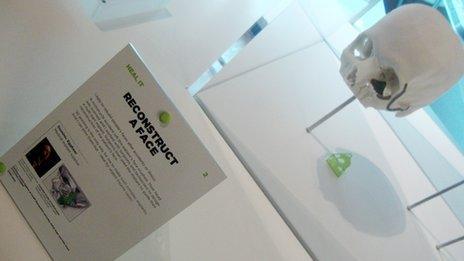3D printing to rebuild patient's face at Morriston Hospital
- Published

The 3D printing features in an exhibition at London's Science Museum
Surgeons in Swansea are using groundbreaking 3D printing technology to rebuild a patient's face which was crushed in a motorbike accident.
The team at Morriston Hospital has used CT scan images to design titanium implants created by a 3D printer.
The use of this method for injury-related reconstructions is thought to be among the first in the world.
It is being featured in an exhibition at the Science Museum in London before the operation itself is carried out.
There have been cases using custom-made titanium implants to correct congenital conditions, those which arise at birth or shortly after.
However, this is thought to be one of the first such reconstructions following an injury.
It is being led by Morriston Hospital consultant maxillofacial surgeon Adrian Sugar.
Abertawe Bro Morgannwg University Health Board's maxillofacial laboratory services manager and reconstructive scientist Peter Evans said: "The patient suffered trauma and had multiple injuries across his body, including some quite severe facial injuries.
"He underwent emergency surgery at the time and we are now at the stage where we can do a proper reconstruction of his face."
The project is the work of the Centre of Applied Reconstructive Technologies in Surgery (Cartis), external.
The centre was established in 2006 as a partnership between Morriston Hospital's maxillofacial unit and the National Centre for Product Design and Development Research (PDR) based at Cardiff Metropolitan University.
Cartis aims to make Wales a world leader in the research, development and application of advanced medical technologies in surgery.
Mirror image
Mr Sugar and Mr Evans worked with PDR's Sean Peel and Ffion O'Malley to plan the complex surgery, which will involve repositioning the patient's facial bones.
They worked from a CT scan that allowed them to create a mirror image of the unaffected side of the patient's face.
From this they designed guides to cut and position the bones with pinpoint accuracy, as well as implants tailor-made for the patient.
The guides and implants are being produced from medical-grade titanium in Belgium, at one of the world's few specialist 3D printing facilities.
Mr Evans added: "We have done everything up the point of surgery. The concept of the operation has been virtually designed and we hope to do the work very soon.
"The patient's facial symmetry will be restored so he should be back to normal as far as his facial looks are concerned."
The Swansea project is featured in an exhibition called 3D: Printing The Future, external at the Science Museum in London until July 2014.
- Published2 August 2013
- Published14 June 2013
- Published28 March 2012